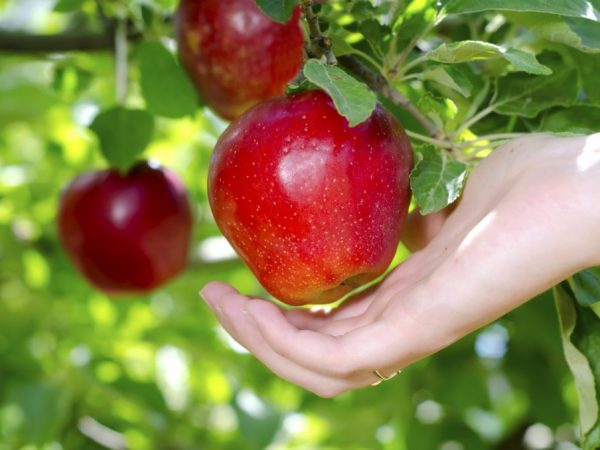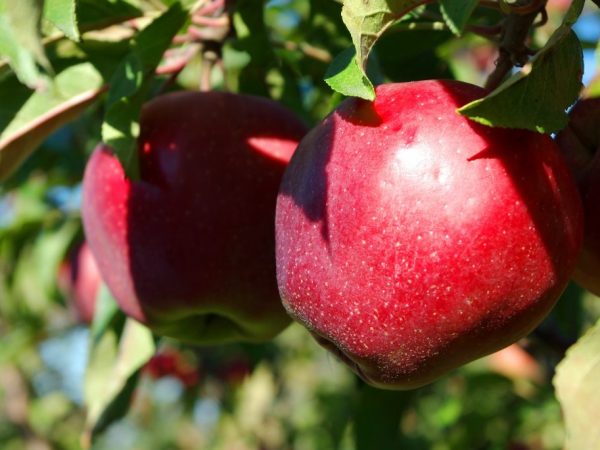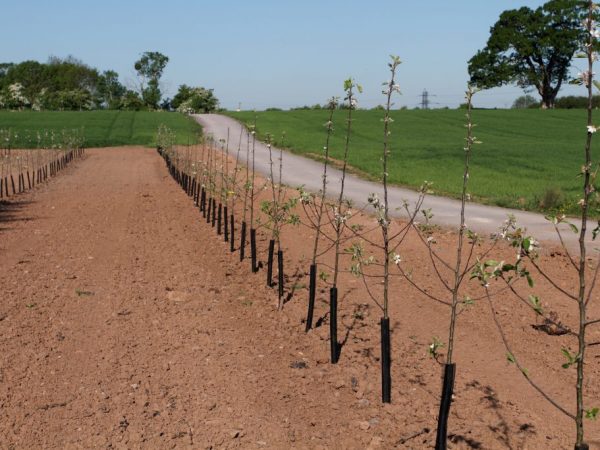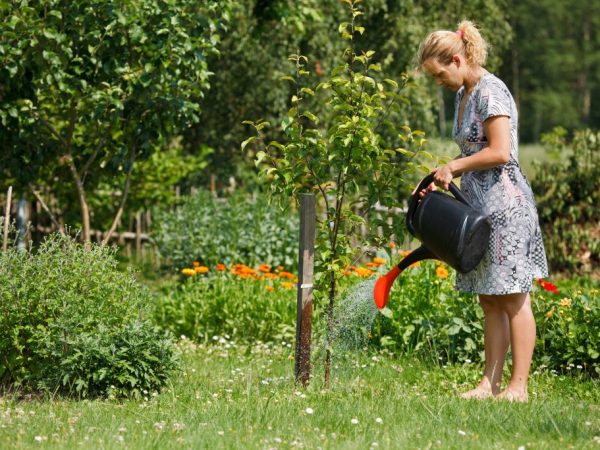Description of Macintosh apples
Macintosh apples are native to America and belong to crops with winter fruiting. On the territory of Russia, where the climate is not so warm and mild, they are classified as autumn. Trees are grown according to a universal scheme: according to it, a crown is formed, fertilizers are applied and irrigation is carried out.
- Apple tree characteristics
- Fruit and tree appearance
- Advantages
- disadvantages
- Potential pollinators
- Fruit qualities
- Disease resistance
- Planting culture
- Landing dates
- Land processing
- General care
- Irrigation works
- Fertilization
- How to deal with pests
- Fruit ripening period
- When to harvest
- Related varieties
- Gardeners reviews

Description of Macintosh apples
Apple tree characteristics
Apple-tree Macintosh is columnar. The tree resembles a poplar or a short cypress.
To maintain the correct shape, the branches are obligatory pruned once a year and sanitary pruning after winter.
Maturity occurs in mid-October. This requires the conditions of a warm summer and rainy autumn. In cold conditions, the fruits can remain on the branches until the end of winter and not lose their marketable appearance.
The first fruiting occurs at 6-7 years. A fast-growing species grows quickly - it takes no more than 2 years. After a period of active growth, all the strength of the tree is spent on the growth of side branches. Most of the fruits are formed on them. Macintosh is famous for its moderate but stable yields.
Average winter hardiness - severe frosts can harm fruits and a weakened tree, therefore, in some regions, which are characterized by prolonged frosts, additional shelter is created for the culture.
Fruit and tree appearance
The tree looks sturdy and will take a lot of free space to grow its wide branches. The culture is medium-sized. The crown is broadly spreading, moderately thinned. Differs in a mixed type of fruiting.
Description of shoots and leaves:
- dark green leaves are small, ovoid, their surface is smooth, and the edges are even, the middle is clearly visible on the plate;
- a yellow tint on foliage appears before the harvest season;
- buds are small and convex, and rounded on top;
- lentils are visible only on a young tree.
Macintosh apples are outwardly beautiful, rather large, their surface is smooth, the top is slightly conical, and the lower part is divided into slices.
There are two colors - red and green, depending on the pollinator of the crop and the amount of sun during the ripening period.
The skin is firm, but separates well from the pulp. The variety is distinguished by a small funnel and a short, thin stalk. Small seed chambers, located below the middle.
Advantages
The Macintosh apple variety has long-lasting fruiting.
Harvesting takes several months, and from spring ovaries appear on the branches. The tree is not "idle".
Storing the crop does not require a lot of waste: ordinary wooden boxes in a cool room will do. The variety is easily transported and does not lose its commercial appearance. Average winter hardiness also belongs to the dignity of the Canadian culture.
disadvantages

Apples on the tree ripen at different times
- No matter how good the growing conditions are, the variety will not produce an increased amount of fruit. Stability in this case refers to consistent fruiting, not yield.
- Low resistance to fungal diseases. If powdery mildew appears, the tree cannot cope with it without special means. In most cases, apples on the same tree ripen at different times.
Potential pollinators
The culture is self-fertile. Pollination of neighboring trees improves the quality of the fruit, but even without them, the variety will bear fruit.
Cross-pollination has a positive effect on the rate of ovary emergence and apple formation. Selected varieties are similar in properties and composition of the fruit.
Fruit qualities
The variety has a decrease in yield in unfavorable conditions. This also affects the quality of the fruit.
On average, apples weigh up to 200 g. One tree allows you to harvest up to 200 kg of the crop. Giant fruits gain weight up to 350 g, which increases the average yield from one tree to 350 kg.
The fruit has an oval shape, slightly compressed at the base. The surface is moderately ribbed. The pulp is juicy and dense, medium-grained.
Disease resistance
According to the description of the variety, fungal diseases are the most dangerous for the Macintosh apple tree. Culture cannot resist them. If powdery mildew or scab appears, then at least half of the tree perishes.
The gardener needs to react in a timely manner to negative changes in the appearance of the tree, otherwise it may completely die.
Pests annoy the culture during the warm season. Destroys the stems and green fruits of aphids. The fruit moth seriously harms the future harvest.
To protect the apple tree, timely prevention is carried out and special protection against pests is put in place.
Planting culture
The secret of the correct registration of the land: fertilizer is applied to the soil, the correct period for planting is selected, and after the seedling takes root, regular feeding is carried out.
Disembarkation rules:
- the distance between the seedlings is at least 40 cm, otherwise the tree will not grow anywhere;
- row width not less than 2 m;
- the soil is constantly loosened around the seedling - such activities are carried out separately or as part of watering, fertilizing the soil;
- top dressing and replenishment are calculated by growth - you cannot use the same soil fertilization scheme all year round.
The apple tree is difficult to tolerate prolonged frosts, so a protected site is chosen. Low ground, which collects stagnant water from the entire garden, is not suitable.

Apple trees need sunshine
The shade adversely affects the condition of the fruit: they will be sour and deformed.
The composition of the soil must be balanced. If clay predominates, a few buckets of sand are added additionally. They do the same with sandy soil - clay is added to the upper layers.
Landing dates
The best time to disembark is early spring or fall. If the first option is chosen, then you need to wait until the upper layers of the soil warmer. Blooming buds on neighboring crops indicate that the opportune moment for planting a seedling has been missed.
Autumn planting is carried out a month before the first frost. If the soil has time to freeze, the seedling will not be accepted. It is better to do a transplant in the summer. Such activities are carried out only with young trees and if there is a threat to the culture - poor soil composition, frequent flooding of the land.
Land processing
The selected area affects the quality of the future harvest. Before planting the crop, the soil is additionally enriched. It is more convenient to carry out top dressing immediately after creating a planting pit. All soil replenishment work is carried out 2-3 weeks before the day of the planned planting. The depth of the pit should be at least 70 cm, taking into account the applied fertilizers.
Disembarkation procedure
A nutrient mixture is added to each well.It consists of manure or compost. It is useful to apply nitrogen fertilizers - they will need no more than 70 g for each hole. If the land plot is characterized by high acidity of the soil, dolomite flour is added. This will create the correct alkaline balance in the soil.
Manure is applied in a thick layer and left in the pit until the crop is planted. Before this, the dried soil is watered abundantly with water. A peg is hammered next to the seedling.
The rhizome is carefully buried and rammed with fresh soil. From above, the seedling is watered with three buckets of purified water. A soil roller is created around the trunk. It will allow you to retain excess moisture and protect the root part from contamination.
General care
The basis of any care is timely watering and fertilization. Regularity in this case is a guarantee of accelerated fruit formation. To stimulate the growth of a young tree in the first spring, special measures are taken: a seedling is cut for 2-3 buds. After that, the side shoots begin to grow actively.
If the tree has well-developed skeletal shoots, they are pruned twice a year. The main purpose of pruning is to reduce the size of the skeletal branches. They should be shorter than the main shoot. Formative pruning, which allows a specific tree appearance to grow, begins in the second year. The central conductors are shortened by 2-3 kidneys. Shoots that go inside are also cut off. All shoots that form sharp corners with the trunk must be cut off.
Weed control is also carried out. This is a big problem for the apple tree. Even small root plants draw all moisture from the rhizome. Weeding and loosening the soil around the trunk will improve the quality of the rest of the work - watering and fertilizing. For stable growth, mulching is carried out: the most suitable for this is the autumn period.
Irrigation works
Immediately after planting, abundant watering is carried out. The seedling is saturated with moisture at the root. Each unit requires at least 4 buckets of water. The next watering is carried out only after a week.
Irrigation works are carried out every few months. It is impossible to fill the rhizome with water, otherwise the young tree may sag.
Fertilization

The tree must be fertilized once a year.
To improve the growth of the Macintosh apple, mineral and organic fertilizers are applied. More often than once a year, feeding is not carried out, otherwise the introduced substances will have the opposite effect.
The best organic matter is manure. Calculation of the optimal proportion: 50 kg of organic matter per one hundred square meters. It is better to feed in the fall.
During the period of active growth, it is imperative to add nitrogenous substances. Phosphate fertilizers allow you to strengthen the culture before the arrival of cold weather. For application, holes are created around the trunk.
If the culture lacks these substances, the ovaries are formed later, and the fruits ripen longer. This trend has continued for several years. The amount of the crop is significantly reduced.
How to deal with pests
As soon as pests appear, urgent cleaning work must be carried out.
For prophylaxis, spraying with a solution is carried out twice a year:
- soapy;
- tobacco;
- karbofos.
An effective option for aphids is Oleocobrite. The powder is diluted in 10 liters of water. In the spring, such spraying is carried out to destroy the larvae of aphids. During the flowering period, such measures serve to prevent the occurrence of fungal diseases. At the end of flowering, spraying consolidates the entire preventive effect. Chemicals cannot be used too often.
Fruit ripening period
The peculiarities of the species appear during the period of fruit formation. The beginning of fruiting falls on the 7th year. Immediately after this, the gardener controls the fruit branches. Such measures will prevent a decline in yield. For this, the kidneys are carefully removed.
For the first time, an apple tree blooms in the second year. This period starts from May to early summer.After that, maturation is uneven. The apple harvest period starts in August and lasts until October.
When to harvest
You can pick apples in batches or at once. All fruits ripen fully in October. The whole process takes no more than three weeks.
The optimum temperature for harvesting is 10 ° C. After that, the fruits retain their qualities for 4-5 months. At temperatures up to 3 ° C, the crop is stored for up to 7 months.
Related varieties
- Apple-tree "Daughter" is a hybrid of Macintosh. Released in 1969. Has a winter ripening period. The first harvest gives in the 5th year. The fruit has a green color and a red blush.
- Black. Late autumn hybrid with high frost resistance. The tree is not tall, but strong. Fruiting begins in the 4th year. The apples are yellow.
- Cortland. Such hybrids are characterized by a late ripening period. The fruits are massive and elongated. The variety is susceptible to the disease - scab.
- American. Mid-autumn hybrid. The tree has a rounded crown. The apples are red with juicy pulp. The fruits are high in vitamins.
Gardeners reviews
Reviews of the Macintosh apple tree are positive.
Its significant disadvantage is susceptibility to fungal diseases. Stably one tree gives a harvest, but it also needs to be harvested on time.
It is advised to properly prepare the land plot so that the culture develops faster. The system of fertilizers and feeding will speed up the process of crop formation.
If you follow all the tips, the Mac will become a real decoration of any garden.

